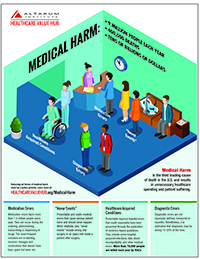Medical Harm
Medical Harm is the third leading cause of death in the U.S. and results in unnecessary healthcare spending and patient suffering.
-
Impacts nine million people each year
-
Causes 400,000 deaths
-
Costs tens of billions of dollars
Diagnostic Errors
Diagnostic errors are not rigorously defined, measured or reported. Nonetheless, it is estimated that diagnoses may be wrong 10-20% of the time.
Meghan has a rash on her leg. A doctor at an urgent care center performs a physical exam and diagnosis an allergic reaction. The doctor fails to identify Meghan’s problem as cellulitis. After three days she develops a fever and is hospitalized with a life-threatening bacterial infection.
Healthcare Acquired Infections
Injurious hospital infections that could reasonably have been prevented using evidence-based practices. The CDC estimates more than 720,000 hospital patients are infected each year and 75,000 of them die from the infections.
Jose undergoes a routine surgery. While recovering at the hospital he develops a healthcare-acquired condition. The skin around his catheter becomes sore and red and he develops a fever. Antibiotics are prescribed to treat the infection.
Medical Device Errors
Injuries stemming from medical devices that could range from surgically implanted devices to diagnostic devices to external defibrillators.
Todd comes to the hospital with a cough. The oxygen sensor erroneously reads as low and leads to extensive testing to look for pneumonia and blood clots. Todd is eventually discharged and advised to take over-the-counter cough medicine.
Medication Errors
Medication errors harm more than 1.5 million people every year. They can occur during the ordering, administering, transcribing or dispensing of drugs. The most frequent mistakes are in labeling, incorrect dosages and medications that should have been given but were not.
Neal is in the hospital for a routine operation. His doctor in the hospital prescribes 6 units of pain medicine but a nurse misreads the handwritten prescription as 64 units. Neal dies of this medication error.
"Never Events"
Also known as “serious reportable events,” these are preventable and costly medical errors that cause significant patient harm and should never happen. They include wrong site surgery or an object left inside a patient after surgery, blood incompatibility, malfunctioning medical devices and some infections.
Erin requires surgery on her left leg, but the surgeon mistakenly operates on her right leg. Erin will spend additional days in the hospital away from work and family. Erin suffered a “never event.”







